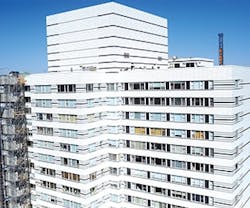The envelope is your building’s primary line of defense, but after so many punctures in its armor, you’ll have to call in the cavalry.
Some enclosure problems can be addressed with sealants and other simple solutions. But when your problems are becoming persistent, epidemic, and particularly costly, it’s time to take more heavy duty measures.
“Buildings aren’t supposed to last forever, and the envelope has a certain lifespan. It can be extended with maintenance and repair, but at some point, it will need to be replaced,” says Bill Bast, principal at engineering firm Thornton Tomasetti. “Eventually, it will literally hit the wall – or what’s left of the wall.”
Let these factors help you decide if recladding is your only remedy.
Envelope Efficiency
Begin by looking for signs of excessive air or water infiltration.
“Moisture penetration is the easiest red flag to identify,” says Mike Radigan, senior operations manager of restoration and preservation firm Western Facades. “It’s also usually the first one that causes people to start kicking, screaming, and withholding rent.”
Water infiltration manifests in a number of ways. Occupant complaints of leaks and ponding at window sills are only the early signs.
“Don’t think of leaks or drafts as normal, everyday complaints,” says Bast. “The building is not intended and designed to behave that way. There might only be a few defective sealants, but there could be a larger scale failure.”
Also look for cracking and efflorescence staining on the exterior.
“If problems are showing up on the exterior, the problem is more insidious,” says Radigan. “Especially on a concrete or steel frame, the system can start deteriorating from the inside. It’s like the skeleton of the building is crumbling.”
Even issues on the roof can indicate facade failures. “Look for cracking, blistering, and bubbling of roof membranes. Look for ponding water that’s not draining correctly. Look for a green roof that’s not supposed to be a green roof, like if it’s growing moss or mold,” says Radigan.
“Getting on top of the building gives a different vantage point,” Bast agrees. “If you have water up there, the problem goes from the top down.”PageBreak
Tools, Tips, and Resources
Apart from enclosure experts and engineers, Radigan recommends involving energy consultants.
“Energy efficiency firms are somewhat new to the enclosure industry, but they’re heavily involved in diagnosis,” he says. “They can also ensure that your replacement is airtight and if it might yield energy savings.”
There are also unlikely resources outside of the design community.
“Architects like to design buildings, but not necessarily fix them,” Bast notes. “Contractors and window washers – trades that are actually working on the building – can be your eyes and help you notice troublesome things.”
User friendly devices will help you know if the problem is a bigger deal than you initially thought.
“Infrared cameras can be used with some training and they’ll let you know where leakage might be occurring. But at first it’s kind of like looking at an X-ray without a medical degree,” Bast explains. “Crack monitors are an easier device and can let you know if the problem is growing.”
When failures become more invasive and intensive, full-scale recladding may be the best route.
Recladding for Results
“There are going to be more reclad projects coming up. There are a lot of buildings of the post-World War II vintage that are having problems,” Bast says. “Excessive leakage is something that can’t be fixed with the Band-Aid approach. It’s a defect that will never get fixed with sealants.”
Western Facades recently completed full-scale replacement of a facade on a New York rental property. The former system was glazed white brick that had so much water infiltration, some faces of the bricks popped off.
“The system had clearly reached the end of its lifespan. The owner was spending lots of money every few years on little fixes across the building,” Radigan says. “Recladding presented the opportunity to improve the look and function.”
The solution entailed an air cavity, new insulation, and terra cotta rainscreen. Savings will be realized through the efficient barrier and because the system requires less maintenance and repair than traditional masonry.
Many brick and stone buildings are facing the corrosion of their embedded steel support systems, Bast notes. Sandstone veneers such as marble and granite – popular in 1960s construction – are losing strength over time, he adds.
“If the marble starts to bow, it’s starting to fail. Early enough you can post-install anchors to strengthen it, but sometimes that requires full-scale facade replacement,” Bast says. “This problem, like so many others, is fairly common and well-known. But if issues are overlooked for long enough, the remedies can be drastic.”
Chris Curtland christopher.curtland @buildings.com is assistant editor of BUILDINGS.
